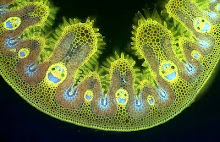Carnivorous plants have a problem. On the one hand, they must catch and digest insects to supplement the meagre soil nitrogen supplies in the boggy habitats that they inhabit. On the other hand, they depend on insects to pollinate their flowers, so there is no future in 'biting the hands that feed them' to the extend that they produce no seed. So most tend to have flowers that are well separated from their lethal, carnivorous leaves by a long flower stem - and this attractive butterwort from Mexico, Pinguicula moranensis, is no exception.
This species makes an excellent plant for the cool conservatory, for two reasons. One is that it produces these attractive magenta blooms from late autumn right through until early summer.
The second reason is that it's a formidable consumer of several annoying greenhouse pests, including whitefly, greenfly and those annoying little mushroom gnats that tend to come with many brands of today's potting composts. The way in which small insects are attracted to the glutinous glands on the leaves and are then trapped and digested is very satisying - and you can see some examples of butterwort's insect catching prowess here. This plant is flowering flypaper.
This species is very easy plant to propagate - just pull the leaves away from the leaf rosette and insert each to a depth of about 5mm. in a moist compost. Buds will develop at each leaf base, to produce a new rosette, much as they do when you propagate an African violet or Streptocarpus species.
Place butterworts amongst your conservatory plants and they will act as a form of botanical biological insect control; they won't eliminate your pest problems but they will produce tangible evidence that they are making inroads into the insect pest population. This plant comes with a feelgood factor if you are troubled by tiny winged insect pests.
Seen from the side, it's clear that this butterwort's flowers must be pollinated by long-tongued butterflies, landing in the flat-faced flower and probing with a long proboscis to the bottom of that long nectar spur behind the flower. The flower is the only part of the plant without adhsive and digestive glands - look closely at the flower stalk (double-click) and you can see here that it's coated with adhesive glands that have caught a few tiny greenfly.
















